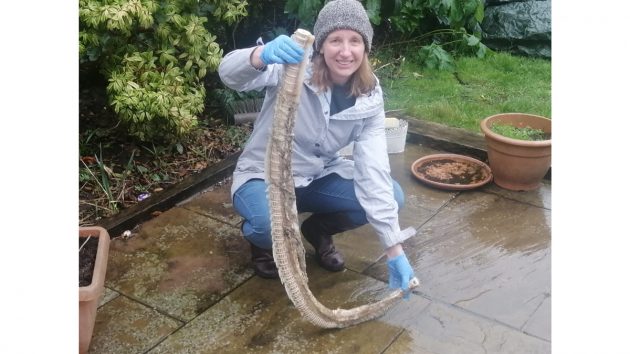PBO editor Ali Wood reveals the mystery 4ft backbone she found on a Dorset beach on Tuesday, which is being investigated by the Shark Trust
It’s not every day you come across what might be a shark’s spine. I love beach-combing for fossils and shark’s teeth, and have even swum with seals and dolphins, so when I spotted this unusual specimen on Southbourne beach I knew it was special!
Belonging to something dead
I didn’t know it belonged to a shark at first. It looked like an old bike tyre, but it stank of decomposing fish. It had washed up on the promenade after the recent storms and was white and immaculately strung together – like an engineered piece of plastic. However, when I saw the inch-thick discs with bloody pieces of flesh hanging off, I knew it belonged to something dead!

The 4ft spine, possibly from a shark was found on the promenade in Southbourne, Dorset. Photo: Ali Wood
About to cycle into Bournemouth to sign off the May edition of Practical Boat Owner, I had to leave it where it was. However, throughout the day – between correcting page proofs – I found myself Googling the spines of various marine mammals. I excluded seals and dolphins, whose spinal cords appeared to be more splayed.
Shark spine?
I could find only two similar examples of spinal cords – one belonging to a thresher shark, which is a seasonal visitor to British waters, and another (larger one) belonging to a Great White shark in Massachusetts.
A poster on shark anatomy by the Shark Trust also suggested to me that the backbone had come from a shark.
I popped into Tesco to get a 10p carrier back and cycled back to the beach.
By now it was dark and pouring down with rain. I wasn’t sure I’d find the spine again; dozens of people and dogs must have walked past it throughout the day, not to mention litter pickers, and it was on a stretch of prom with no lighting.
Article continues below…
Cold water swimming gear: Everything you need to take the plunge all year round
There’s no better way to lift the spirits than an outdoor swim. Whether you’re a dipper or a swimmer, the…
Wally the Walrus – boat owner films incredible encounter in Isles of Scilly
Wally the Walrus made national news last week when he climbed aboard people’s boats in the Isles of Scilly, where…
Giant shark spine found in Bournemouth – species revealed
A giant shark spine found near Bournemouth, Dorset, on Tuesday has been identified as a basking shark. PBO editor Ali…
I needn’t have worried. In the pitch black, when senses are heightened, I could smell it long before I saw it! Wearing my son’s gloves, which happened to be in my rucksack, I picked up the spine and coiled it into the shopping bag.
It reminded me, rather horribly, of a dead corn snake I found in the toy box once, which had escaped from the flat above! Only this thing was really quite heavy and cumbersome – especially dangling off my bike handlebar.
Examining the specimen
I tied it in a bin bag overnight to hide it from our tame fox and the following morning got some rubber gloves out. I put the spinal cord on the patio, gently washed off the sand and photographed, measured and videoed it.

The possible shark vertabrae were 3-4cm wide. Photo: Ali Wood
The fully intact spine was over 120cm long, slightly curved, with the largest vertebra measuring 4cm in diameter.
I consulted the British Shark poster on my daughter’s bedroom wall. Many of our seasonal sharks are longer than the spine I found, including the huge and sadly endangered basking shark (1,000cm), Greenland shark (640cm), thresher shark (610cm), the blue shark (383cm) and the shortfin mako (390cm). Of the resident British sharks, there’s the critically endangered porbeagle shark (300cm), tope (175cm), nursehound (162cm) and many others.
Shark Trust to investigate
Intrigued, I called the Shark Trust and got hold of director of conservation Ali Hood. I told her about the possible shark spine I’d found near Bournemouth beach.
“That sounds fascinating,” she said, “I’d be pleased to see the images.”
I sent them to Ali and also managing director Paul Cox. Whilst neither want to speculate on its identity at this stage, they were pleased I’d kept it, and described it as ‘interesting’ and ‘impressive’. Paul has forwarded the photos and images to a colleague, a shark taxonomist in California, and they will give a full comment when they know more.
A rare find
Shark backbones are a rare find because they’re made of cartilage, not bone. However, according to fisheries scientist Greg Skomal, who reported on the Massachusetts shark spinal cord, they also have high amounts of calcium, which allows them to preserve well.

The possible shark vertebrae, once washed, looked remarkably intact. Photo: Ali Wood
Whatever it turns out to be, I am very glad I went back for it and look forward to finding out more. The Shark Trust does wonderful work in conservation and education and I’m so thrilled they’ve taken an interest. Knowing that when I swim in the sea, I’m sharing the water with such fascinating creatures as whales, dolphins and sharks, makes the experience all the more exciting.
If you think you know what this is, or have an interesting marine find to share, please email us at pbo@futurenet.com







